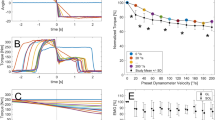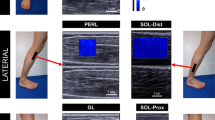Abstract
In this combined in vivo and computational modeling study, we tested the central hypothesis that ankle joint rotation and triceps surae muscle loading have independent and combinatory effects on the calcaneal (i.e., Achilles) tendon moment arm (CTma) that are not fully captured in contemporary musculoskeletal models of human movement. We used motion capture guided ultrasound imaging to estimate instantaneous variations in the CTma during a series of isometric and isotonic contractions compared to predictions from scaled, lower extremity computational models. As hypothesized, we found that muscle loading: (i) independently increased the CTma by up to 8% and (ii) attenuated the effects of ankle joint rotation, the latter likely through changes in tendon slack and tendon curvature. Neglecting the effects of triceps surae muscle loading in lower extremity models led to an underestimation of the CTma, on average, particularly in plantarflexion when those effects were most prominent. We also found little agreement between in vivo estimates and model predictions on an individual subject by subject basis, alluding to unaccounted for variation in anatomical morphology and thus fundamental limitations in model scaling. Together, these findings contribute to improving our understanding of the physiology of ankle moment and power generation and novel opportunities for model development.





Similar content being viewed by others
References
Arnold, A. S., M. Q. Liu, M. H. Schwartz, S. Ounpuu, and S. L. Delp. The role of estimating muscle-tendon lengths and velocities of the hamstrings in the evaluation and treatment of crouch gait. Gait Posture 23:273–281, 2006.
Arnold, E. M., S. R. Ward, R. L. Lieber, and S. L. Delp. A model of the lower limb for analysis of human movement. Ann. Biomed. Eng. 38:269–279, 2010.
Baxter, J. R., and S. J. Piazza. Plantar flexor moment arm and muscle volume predict torque-generating capacity in young men. J. Appl. Physiol. 116(538–544):2014, 1985.
Baxter, J. R., and S. J. Piazza. Plantarflexor moment arms estimated from tendon excursion in vivo are not well correlated with geometric measurements. J. Biomech. 2018. https://doi.org/10.1101/290916.
Bruening, D. A., A. N. Crewe, and F. L. Buczek. A simple, anatomically based correction to the conventional ankle joint center. Clin. Biomech. 23:1299–1302, 2008.
Choi, H., K. Bjornson, S. Fatone, and K. M. Steele. Using musculoskeletal modeling to evaluate the effect of ankle foot orthosis tuning on musculotendon dynamics: a case study. Disabil. Rehabil. 11(7):613–618, 2016.
Csapo, R., J. Hodgson, R. Kinugasa, V. R. Edgerton, and S. Sinha. Ankle morphology amplifies calcaneus movement relative to triceps surae muscle shortening. J. Appl. Physiol. 115(468–473):2013, 1985.
Delp, S. L., F. C. Anderson, A. S. Arnold, P. Loan, A. Habib, C. T. John, E. Guendelman, and D. G. Thelen. OpenSim: open-source software to create and analyze dynamic simulations of movement. IEEE Trans. Biomed. Eng. 54:1940–1950, 2007.
Fath, F., A. J. Blazevich, C. M. Waugh, S. C. Miller, and T. Korff. Direct comparison of in vivo Achilles tendon moment arms obtained from ultrasound and MR scans. J. Appl. Physiol. 109(1644–1652):2010, 1985.
Fath, F., A. J. Blazevich, C. M. Waugh, S. C. Miller, and T. Korff. Interactive effects of joint angle, contraction state and method on estimates of achilles tendon moment arms. J. Appl. Biomech. 29:241–244, 2013.
Hashizume, S., S. Iwanuma, R. Akagi, H. Kanehisa, Y. Kawakami, and T. Yanai. The contraction-induced increase in Achilles tendon moment arm: a three-dimensional study. J. Biomech. 47:3226–3231, 2014.
Hawkins, D., C. Lum, D. Gaydos, and R. Dunning. Dynamic creep and pre-conditioning of the Achilles tendon in-vivo. J. Biomech. 42:2813–2817, 2009.
Lee, S. S., and S. J. Piazza. Built for speed: musculoskeletal structure and sprinting ability. J. Exp. Biol. 212:3700–3707, 2009.
Lee, S. S., and S. J. Piazza. Correlation between plantarflexor moment arm and preferred gait velocity in slower elderly men. J. Biomech. 45:1601–1606, 2012.
Maganaris, C. N. Imaging-based estimates of moment arm length in intact human muscle-tendons. Eur. J. Appl. Physiol. 91:130–139, 2004.
Maganaris, C. N. Validity of procedures involved in ultrasound-based measurement of human plantarflexor tendon elongation on contraction. J. Biomech. 38:9–13, 2005.
Manal, K., J. D. Cowder, and T. S. Buchanan. A hybrid method for computing achilles tendon moment arm using ultrasound and motion analysis. J. Appl. Biomech. 26:224–228, 2010.
Manal, K., J. D. Cowder, and T. S. Buchanan. Subject-specific measures of Achilles tendon moment arm using ultrasound and video-based motion capture. Physiol. Rep. 1:e00139, 2013.
Neptune, R. R., D. J. Clark, and S. A. Kautz. Modular control of human walking: a simulation study. J. Biomech. 42:1282–1287, 2009.
Olszewski, K., T. J. Dick, and J. M. Wakeling. Achilles tendon moment arms: the importance of measuring at constant tendon load when using the tendon excursion method. J. Biomech. 48:1206–1209, 2015.
Pekala, P. A., B. M. Henry, A. Ochala, P. Kopacz, G. Taton, A. Mlyniec, J. A. Walocha, and K. A. Tomaszewski. The twisted structure of the Achilles tendon unraveled: a detailed quantitative and qualitative anatomical investigation. Scand. J. Med. Sci. Sports 27:1705–1715, 2017.
Rasske, K., and J. R. Franz. Aging effects on the Achilles tendon moment arm during walking. J. Biomech. 77:34–39, 2018.
Rasske, K., D. G. Thelen, and J. R. Franz. Variation in the human Achilles tendon moment arm during walking. Comput. Methods Biomech. Biomed. Eng. 20:201–205, 2017.
Siston, R. A., A. C. Daub, N. J. Giori, S. B. Goodman, and S. L. Delp. Evaluation of methods that locate the center of the ankle for computer-assisted total knee arthroplasty. Clin. Orthop. Relat. Res. 439:129–135, 2005.
Sugisaki, N., T. Wakahara, K. Murata, N. Miyamoto, Y. Kawakami, H. Kanehisa, and T. Fukunaga. Influence of muscle hypertrophy on the moment arm of the triceps brachii muscle. J. Appl. Biomech. 31:111–116, 2015.
Szaro, P., G. Witkowski, R. Smigielski, P. Krajewski, and B. Ciszek. Fascicles of the adult human Achilles tendon—an anatomical study. Ann. Anat. 191:586–593, 2009.
Waugh, C. M., A. J. Blazevich, F. Fath, and T. Korff. Can Achilles tendon moment arm be predicted from anthropometric measures in pre-pubescent children? J. Biomech. 44:1839–1844, 2011.
Wolfram, S., C. I. Morse, K. L. Winwood, E. Hodson-Tole, and I. M. McEwan. Achilles tendon moment arm in humans is not affected by inversion/eversion of the foot: a short report. R. Soc. Open Sci. 5:171358, 2018.
Acknowledgments
Funded by NIH (R01AG051748) and the National Center for Simulation in Rehabilitation Research (NIH, P2CHD065690). We thank Ms. Brianna Arnold for assisting with some data analysis.
Author information
Authors and Affiliations
Corresponding author
Additional information
Associate Editor Thurmon E. Lockhart oversaw the review of this article.
Electronic supplementary material
Below is the link to the electronic supplementary material.
Rights and permissions
About this article
Cite this article
Franz, J.R., Khanchandani, A., McKenny, H. et al. Ankle Rotation and Muscle Loading Effects on the Calcaneal Tendon Moment Arm: An In Vivo Imaging and Modeling Study. Ann Biomed Eng 47, 590–600 (2019). https://doi.org/10.1007/s10439-018-02162-4
Received:
Accepted:
Published:
Issue Date:
DOI: https://doi.org/10.1007/s10439-018-02162-4




